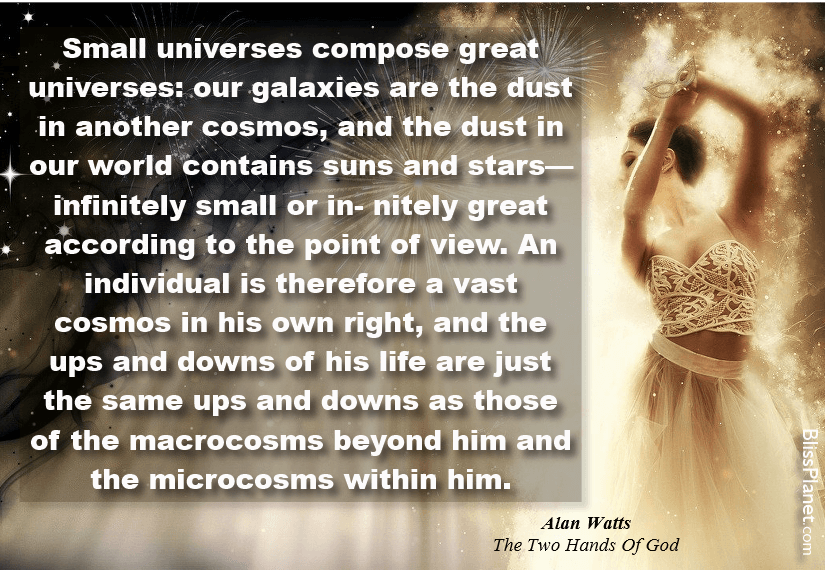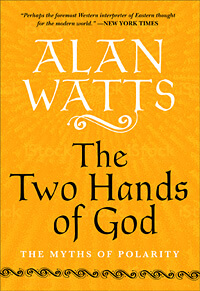Originally published in 1963, The Two Hands of God: The Myths of Polarity is Alan Watts’s forgotten book on world mythology — myths of light and darkness, good and evil, and the mystical unity that sees the transcendent whole behind apparent opposites. Alan Watts is one of the world’s most popular interpreters of Eastern philosophy for a Western audience. Fans of the mythologist Joseph Campbell will immediately notice his influence throughout this book. Campbell and Watts were in fact friends during its writing, and Campbell shared notes and feedback on several chapters. One might even say that The Two Hands of God is Alan Watts’s own introduction to the mythology of the world’s religions, using the nondual lens he was so well-known for in his Zen teachings and study.
We hope you enjoy this excerpt from the book.
What is more exuberant than Hindu sculpture? I am thinking of those ovoid domes of stone at Konarak, Bhuvaneshwar, and Khajuraho, which look, at first sight, as if they had decomposed into the kind of squirming vitality that one finds upon overturning a rock, as if they were alive with anthropoid maggots, swarming together in a colossal rout of dancing, fighting, and copulating. But close inspection reveals that the stone has come alive in figures of unbelievable grace and lilting sensuousness—at one time vividly polychromed, but now perhaps all the better for being the combination of drab gray rock and endlessly dancing form. One must look at these temple figures in the light of classical Hindu dancing—an art in which jeweled bodies move as if they were plants suspended in water, where muscles are an ivory liquid, and where legs, hips, belly, shoulders, and head move quite in dependently in their own planes. Such exotic, rich, and junglelike displays of human fecundity are perhaps repel lent to the Western, and especially Anglo-Saxon, taste. But to penetrate the depth and grandeur of Hindu mythology and philosophy, one must somehow allow oneself to enter into this seething imagery, and then feel one’s way down through its bewildering variety to the simple and presiding intuition which underlies it.
In a world of intense heat, of the most startling extremes of fertility and aridity, wealth and poverty, and where life is cheap and security almost unknown, the human mind can acquire a peculiar sensitivity. Somehow the world seems lack- ing in solidity. External forms and surfaces are now diaphanous, and now bristling with the sharpest points. Nothing is certain but change, and change is less apt to be gradual and orderly than sudden and unforeseen. It is not surprising, then, that to the Hindu consciousness the world has seemed like an arabesque of smoke, and that its totally unreliable transitoriness has been the principal ground for consider- ing it to be fundamentally unreal. But the word maya, by which this peculiar unreality is described, is not necessarily a term of contempt, as if the world were merely an illusion to be dismissed. Maya also means art and magic, and thus a seeming solidity evoked by divine power. But under the spell of this power the Hindu does not feel himself entirely a victim. However obscurely, he knows or feels that the source of this enchantment is in some roundabout way himself—as if being alive and human were to have got oneself deliberately lost in a labyrint.
For the presiding intuition of the Hindu worldview is that the whole universe of multiplicity is the lila, or play, of a single energy known as Paramatman, the Supreme Self. The coming and going of all worlds, all beings, and all things is described as the eternal outbreathing and inbreathing of this One Life—eternal because it is beyond all dualities, comprising nonbeing as much as being, death as much as life, stillness as much as motion. One of the principal symbols of the Paramatman is the Swan, Hamsa, ying forth from its nest and returning, and the syllable ham stands for breathing out, sa for breathing in. As the exhalation and in- halation are repeated endlessly, ham-sa ham-sa-ham-sa-ham, there is also heard saham, that is, sa aham, “He I am”—which is to say that the essential self of every being is the Supreme Self.
This in-and-out rhythm or undulation goes on endlessly through every dimension of life. It is the birth-and-death of innumerable universes, not only succeeding one another in kalpa-periods of 4,320,000 years, but also coexisting in un- told myriads. Small universes compose great universes: our galaxies are the dust in another cosmos, and the dust in our world contains suns and stars—infinitely small or in- nitely great according to the point of view. An individual is therefore a vast cosmos in his own right, and the ups and downs of his life are just the same ups and downs as those of the macrocosms beyond him and the microcosms within him. To the eye of wisdom size makes no difference: every mote, every being, every cosmos is an exemplar of the one archetypal rhythm. All beings—divine, human, demonic, or animal—are, as it were, under the spell of the Juggler, toss- ing and catching the multitudinous balls of the worlds with his thousands of arms and hands, simultaneously giving de- light with the display of skill and terror with the thought that a ball might drop. Yet the skill and resourcefulness of the Divine Juggler are endless. The ball that seems to drop and shatter simply bursts into a million more Jugglers; the disaster turns out with unfailing astonishment to be a new tour de force, though it is all part of the game that this shall never be expected. Yet there is a clue for the wise. In all images of the many-armed divinity there is one hand raised and unmoving, with palm toward the beholder—the gesture of “Fear not.” It is just a game.
This, then, is the underlying theme of those Hindu art forms depicting the myriads of gods and goddesses in their loves and wars: it is the endless complication of a single principle, complicated by an in nite capacity for maya, for concealing the stratagem. Now you see it, now you don’
Alan Watts (January 6, 1915 – November 16, 1973) was a British-born American philosopher, writer, speaker, and counterculture hero, best known as an interpreter of Asian philosophies for a Western audience. He wrote more than 25 books and numerous articles applying the teachings of Eastern and Western religion and philosophy to our everyday lives.
Excerpted from the book The Two Hands of God. Copyright © 2020 by Joan Watts and Anne Watts, © 1963 by Alan Watts.







